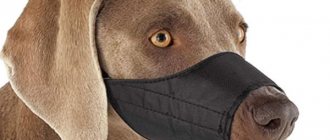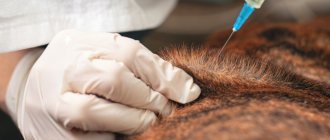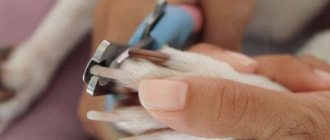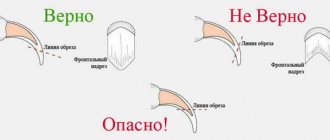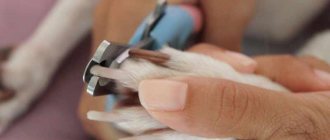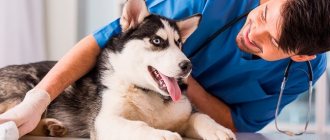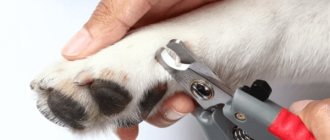- 19.11.2017
- Animals, Pet health, Dogs, Articles, Explanatory
The illness of a beloved dog is always a disaster for the owner. If there are any symptoms of illness, we grab our pet and rush to the veterinarian. After an examination and the necessary tests, the doctor makes a diagnosis and prescribes treatment, one of the main components of which is almost always intramuscular injections of various medications. If two or three injections are required, the veterinarian gives them himself. But often, a long course of injections is needed for complete recovery. In order not to torment a sick animal with daily trips to the clinic, the owner should be able to “give” injections on his own. The veterinarian will always teach you how to give a dog an intramuscular injection - he will tell you about the correct dosages, choosing the appropriate syringe size, and the procedure technique. And if there is no veterinarian at hand, then our article prepared by him will help you.
Why do you need such skills?
The ability to give an injection may be required when:
- the medicine must be administered immediately;
- there is no opportunity to show the animal to a veterinarian in the near future;
- the dog is very nervous when visiting the “doctor”;
- a long course of treatment is required (you can save money by visiting the clinic).
Important! You need to understand that there are drugs that can only be administered by injection by a veterinarian. This primarily applies to vaccines (including against rabies). Self-administered vaccinations are not recognized by any health service. Vaccination must be performed in a certified clinic; the procedure must be certified by a veterinarian’s signature and seal.
Necessity
It happens that there is simply no opportunity to contact an experienced specialist. And the future life of the pet (or, even worse, the pet and her litter) will depend on the timely administration of the drug. Many people at such a moment can become confused and the outcome of such stories is very disastrous - from the death of a dog to the death of the entire litter.
But having an understanding of the procedure and the ability to cope with one’s own fear, a person is able to make the necessary injection for its administration.
Required documents confirming vaccination
The ability to quickly and correctly give an injection will not only save money, time and nerves, but in some situations it will help save the dog’s life.
This is especially true in acute conditions - poisoning, severe pain due to injuries, and the like. For example, quickly administered Pyridoxine during symptoms of Isoniazid poisoning gives the dog a great chance of survival. You can read more about this in the article “How dog hunters poison dogs. How to act in case of poisoning." Intramuscular injections are prescribed for almost all diseases. After all, the same active substance, introduced into the body in the form of an injection solution, “works” much faster than tablets, since it enters directly into the blood. This feature is important for diseases accompanied by vomiting - when no medications simply can be absorbed from the stomach. By carefully following all the specialist’s recommendations, you will quickly master the technique of performing intramuscular injections - whenever necessary, you will be able to help your dog. When carrying out this difficult manipulation, it is important to choose the right injection site, select/prepare the syringe correctly, and perform the procedure technically. Let's talk about everything in more detail.
Complications
Failure to comply with the rules for carrying out such manipulations is fraught with complications. Moreover, they happen even to people with experience.
Lameness
The dog may experience lameness. Typically, the complication manifests itself after painful injections, during which the animal even whines or breaks out. A nerve may also be affected.
If lameness does not go away for a long time, you should consult a doctor
To improve the condition, the injection site is gently massaged several times a day with rubbing movements clockwise and in the opposite direction. If a lump pops up at the injection site or the condition has not returned to normal after two days, the help of a doctor is needed.
Formation of infiltrate
In the tissues where the injection was administered, an infiltrate sometimes forms, that is, cellular elements mixed with blood and lymph, and sometimes pus, accumulate in this area.
Errors that cause this phenomenon:
- infusion of the drug into the same place on the animal’s body;
- ignoring the norms of asepsis and antisepsis;
- improper removal of the needle when working with irritating compounds;
- infusion of an irritating drug under the skin or into connective tissue;
- the use of cold preparations, especially suspensions, as well as oily solutions, biological drugs.
To avoid such a complication, it is necessary to constantly change the location of the infusions, and not to inject irritating agents under the skin. Before use, the compositions are heated, especially oil ones, to avoid vasospasm and speed up the resorption of the solution. The infiltrate is resolved by iodine mesh or heat.
An iodine grid will help
Attention! You should not heat the damaged area if the swelling becomes larger and itches. This is a reason to contact a veterinarian.
Abscess
With this complication, a cavity forms in the skin where pus accumulates. The development of phlegmon, a purulent-diffuse inflammation, is also likely.
Subcutaneous abscess in a dog
With purulent inflammation, the temperature locally rises, the size of the swelling increases, and at the first stage it thickens. At the end of its formation, the formation softens in the center or in several places. When touching the abscess, the dog feels pain. The pet may develop a fever and refuse to feed. All sorts of digestive upsets and dehydration can occur.
Different syringes are used for different medications
The main reasons for the complication are the same - violation of aseptic and antiseptic standards, as well as infusion of medicine into loose tissue. To prevent an abscess, you should:
- use a new syringe for each product;
- use medications from ampoules that are opened immediately before use;
- treat the injection site with alcohol for intravenous, intraarterial, intraosseous administration.
At the initial stage, the abscess is treated with short novocaine blockades, and other options of physiotherapy are resorted to. In the final stages, surgical methods are used to clean the abscess cavity from pus.
Reference. A short novocaine blockade is an anesthesia in which the medicine is administered around the inflamed area.
Tissue necrosis
This is a process in which destruction and death of tissue occurs, accompanied by the formation of blisters and ulcerations. The dog feels pain at the injection site, swelling and bluish skin develops.
Necrosis often occurs after improper administration of irritating substances. To prevent this, the patency of the catheters through which drugs are administered should be checked.
If, during intravenous administration, the drug spills under the skin, then they try to draw out the solution with a syringe, and inject the affected area with novocaine. An effective measure is applying a cold compress.
Applying ice is an effective method
Allergic reaction
Usually occurs in response to the administration of a low-quality, expired drug or hypersensitivity to this drug in an animal. To prevent this, a sensitivity test is performed before administration. If symptoms of a sharp allergic reaction occur - for example, convulsions, respiratory problems, then the administration of the drug is stopped and antihistamines are used.
Allergy in a dog
You can read more about allergies in dogs on our website.
Where to inject - choose and prepare the place
“Giving” an intramuscular injection is not easy, especially when the owner has no experience in carrying out this procedure. Everyone is scared for the first time - what if I inject in the wrong place, what if I puncture a nerve, what if I damage a bone or vessel with a needle. Psychologically, it is also very difficult to stick a syringe into a pet’s paw. Here it is important to understand that you are not torturing the animal, but on the contrary, you are prolonging its life and taking care of its health. Following our instructions, you can inject your dog. So:
Injections are given intramuscularly in the hind leg. Carefully examine your pet's paw from the side, assessing the volume of muscles, thickness of bones and skin. The picture below clearly shows the area that should be carefully palpated.
The blue dot is the right place
The burgundy lines are the pelvic bone, femur bone, tibia (small and large). The dog needs to give an intramuscular injection into the thigh muscle, approximately where we see the blue dot in the picture.
Important! The safest area is from the femur on the right, if you look at the left paw, if at the right, then vice versa. It is in this part that there are no large blood vessels, tendons, or nerve endings; the bone is located far from the site of needle insertion. Therefore, even without experience, there is no chance of harming anything to the dog.
The needle should be inserted into the most powerful part of the muscle ; it can be easily felt - you will always feel how the muscles roll during palpation. Above/below the muscle is thinner, it is taut and hard. It is extremely undesirable to stab into these places - it will hurt the animal, and you can damage a nerve, bone, or joint.
During the procedure, the muscle must be relaxed . You can relieve tension if you lightly massage the injection site when the paw is in a bent position. Before inserting a needle, it is not necessary to treat the injection site with alcohol - the dog’s skin is distinguished by the presence of a reliable antibacterial layer.
General Tips
If we remove the specifics and give a few general tips that can help carry out all these procedures faster, more pleasantly and efficiently, then the main thing here, of course, will be simply to show love for the dog. This lies in the maximum responsibility and affection that the dog feels.
To make it easier, you can read not only the text tips and instructions, but also watch several videos on how to give injections to dogs.
Choosing the right syringe
Syringes of different volumes and purposes
The moment is very important. The needle cut and syringe volume are selected individually for each dog.
- For small breeds (up to 10 kg), syringes with a thin needle with a volume of up to 2 ml are ideal. If the dose of the administered drug does not exceed 1 ml, it is recommended to use insulin syringes. But if it is necessary to carry out a long course of treatment, it is better not to use them - a small needle does not penetrate deeply into the muscle, and the therapeutic effect is weakened.
- For large breeds, syringes of 2 ml or more are suitable. To reduce injuries to a minimum, you can take a syringe with a larger volume, and a needle from a syringe with a smaller volume.
Preparation
Lack of skills is the most common problem. Some people have to pick up a syringe for the first time in their lives. Naturally, this is accompanied by anxiety or even mild panic. You can practice in advance on a small soft toy, using a separate syringe and water, and then call your pet.
Hands must be clean. You can use gloves, but if you are not used to them, they may be uncomfortable. There is no particular need to treat your dog's skin with alcohol wipes or other antiseptics. But if you really want to, it can be done. The syringe must be prepared in advance. Take the drug, remove excess air and put it at hand.
Sometimes doctors immediately draw the medicine into syringes for several injections. In this case, you need to carefully figure out which drug to inject where and in what dosage. It happens that owners enter everything at once. In recipes you can find the following symbols:
- S/c – subcutaneously;
- V/m – intramuscularly.
How to give an intramuscular injection to a dog
Immediately after injecting, evaluate whether the muscle is thick enough. The needle should enter approximately one centimeter, piercing the skin and subcutaneous fat. Small breeds have dry muscles and thin skin - this must be taken into account so that when injecting you do not pierce the muscle through. To avoid this trouble, it is recommended to take a needle from an insulin syringe and put it on a regular one of suitable size. For large dogs - if the administered dose of medication is small, then, on the contrary, a needle of the required length from the usual one is put on the insulin syringe.
Next, we sharply, confidently and without hesitation, insert the needle into the muscle. Smoothly, carefully press on the piston. It will be more convenient if you support the thigh with the palm of your free hand - this way the muscle will not move under the pressure of the needle and medication. If you need to administer a large dose, but the drug is painful, press the piston slowly and evenly. We remove the needle with a sharp movement at exactly the same angle as we inserted. Immediately after this, we carefully massage the injection site, and do not forget to praise the dog and treat him with his favorite treat.
To perform an injection according to all the rules you must:
- insert the needle into the muscle at a right angle;
- press the syringe plunger slowly and carefully;
- after complete administration of the drug, remove the syringe slowly and smoothly;
- For better distribution of the medicine and pain relief, a light massage in the injection area is necessary.
Important! When performing an intramuscular injection, always hold the needle at the base with your finger - this will allow you to act clearly in unforeseen situations:
- After entering the muscle, it is strictly forbidden to move the needle to the right or left - the dog will be in great pain.
- If you suddenly bump into something hard (maybe bone), quickly but smoothly pull the needle out.
- If blood appears when inserting a syringe, the vessel is damaged. We take out the needle, wipe the wound with a disinfected cotton swab, and “put” the injection in another place.
- After the injection, a hematoma may develop - to remove it, an “iodine mesh” is made and magnesium is used.
Subcutaneous injection
A hypodermic injection should be given to the dog at the withers.
- The withers are a small area of a dog's fur where the shoulder blades of the forelimbs meet.
- It is not difficult to find it, since in this place there is a small excess of skin into which the injection will need to be placed.
- Pull back the withers a little and carefully, gradually wind the syringe.
If everything is done correctly, the needle will enter without any problems and the liquid will flow out of it without any effort.
A few important rules
- You cannot increase the dosage of the drug on your own.
- You should not touch the sterile needle with your hands, even if they are washed.
- A new sterile syringe must be used for each injection.
- Administration of the drug is permitted only if there is no wound, inflammation or irritation on the skin in the injection area.
- Medicine that is stored in the refrigerator must be warmed to room temperature before administration.
- Without a doctor's permission, you cannot mix several drugs in one syringe.
If you are not confident in your abilities or are afraid to give injections yourself, entrust this task to a specialist. The Bio-Vet clinic employs qualified veterinarians. If necessary, they will come to your home to avoid putting your dog under the stress of a hospital visit. Trust the health of your pet to professionals! Our branches are located in all districts of Moscow, in Reutov and Lyubertsy.
